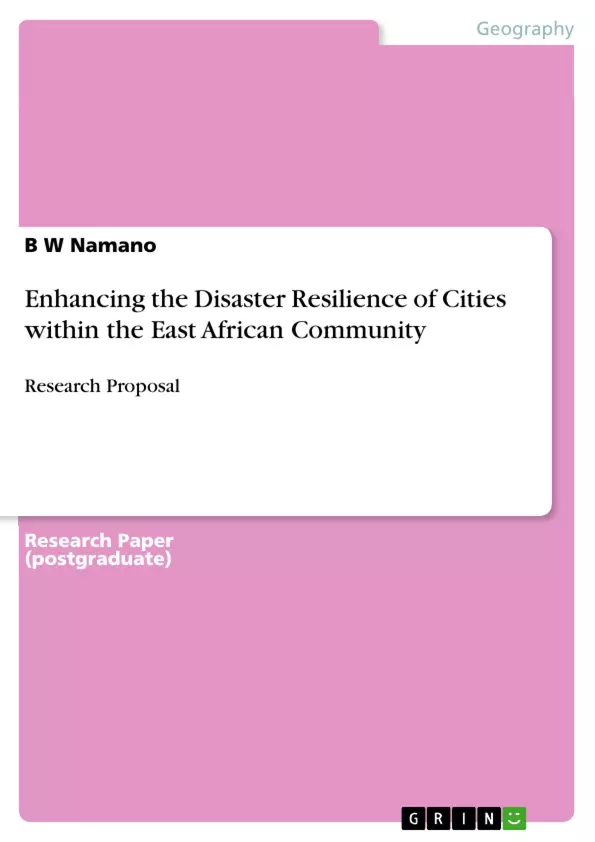This research seeks to enhance the disaster resilience of cities within the EAC by: (a) developing a data base of acute disasters that are common and likely to occur in cities within the EAC, (b) measuring the resilience of major cities within the EAC to these disasters, and (c) developing a framework for enhancing their resilience to potential hazards. It is important to conduct this study now because the present and projected demographic and geographic changes point to a future of continued: (a) rapid urbanization in developing countries – like the EAC - and (b) escalation in the number of urban disasters. Document review and descriptive research will be used in the study with a sample size of 104 participants being selected from the cities of Dar es Salaam, Nairobi, Kampala, Kigali, and Mombasa. The collected data will be tested for inter-rater reliability, triangulated and instruments checked for content validity. Both measures of central tendency and measures of variability about the mean will be performed on the collected data.
Inhaltsverzeichnis (Table of Contents)
- Introduction
- Background
- Research Problem
- Research questions
- Research Objectives
- Significance of the Study
- Definitions of Significant Terms
- Literature review
- Disasters in the global, regional and urban contexts
- Engineering resilience and ecological resilience
- An integrated approach to urban resilience
- Methodology
- Research Design and Procedures
- Target Population
- Sample Size and Sampling Procedure
- Data Collection Instruments
- Reliability of the Instruments
- Validity of the Instruments
- Data Collection Procedure and Analysis Techniques
- Delimitation of the Study
- Limitations of the Study
- Ethical Considerations
- Timetable
- References
Zielsetzung und Themenschwerpunkte (Objectives and Key Themes)
This research aims to improve the disaster resilience of cities within the East African Community (EAC) by developing a database of common disasters, measuring the resilience of major EAC cities to these disasters, and creating a policy framework for enhancing their resilience. The study is timely given the rapid urbanization and projected increase in urban disasters in developing nations like those in the EAC.
- Urbanization and disaster risks in the EAC
- Measuring and enhancing urban resilience to disasters
- Policy development for disaster resilience in EAC cities
- Data collection and analysis techniques for studying urban resilience
- The significance of urban disaster preparedness and mitigation
Zusammenfassung der Kapitel (Chapter Summaries)
- Introduction: This chapter introduces the research by highlighting the intertwined trends of rapid urbanization and increasing urban disasters. It outlines the research problem, questions, objectives, and significance of the study. It also defines key terms like East African Community, major cities within the EAC, urban disaster, and urban resilience.
- Literature review: This section delves into the theoretical framework of the research, exploring disasters in global, regional, and urban contexts. It examines concepts of engineering resilience and ecological resilience and discusses integrated approaches to urban resilience.
- Methodology: This chapter outlines the research design and procedures, including the target population, sample size, sampling procedure, data collection instruments, reliability and validity of the instruments, data collection procedure and analysis techniques, delimitation of the study, limitations of the study, ethical considerations, and timetable.
Schlüsselwörter (Keywords)
This research focuses on urban resilience, disaster preparedness, data analysis, policy frameworks, and the East African Community. It investigates the challenges of rapid urbanization and its impact on disaster risk in developing countries, with a particular emphasis on the cities within the EAC. Key concepts explored include engineering resilience, ecological resilience, integrated urban resilience approaches, and the development of effective disaster mitigation and response mechanisms.
- Quote paper
- B W Namano (Author), 2016, Enhancing the Disaster Resilience of Cities within the East African Community, Munich, GRIN Verlag, https://www.grin.com/document/313492



